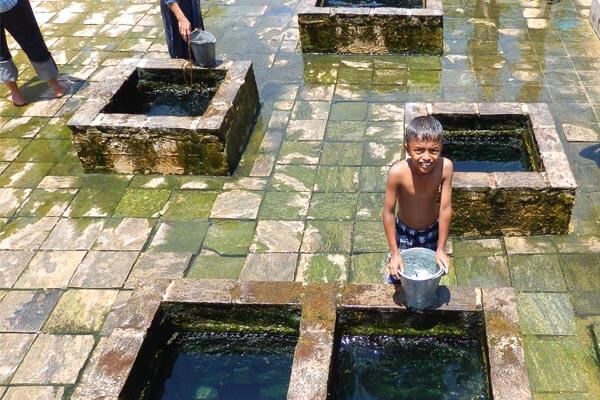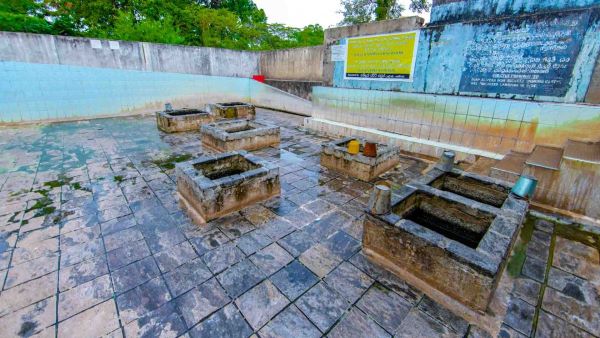Kanniya hot water springs – mythical miracle in Trincomalee
By Arundathie Abeysinghe
 Situated in Trincomalee, Kanniya hot water springs also known as Kanniya hot wells is a popular tourist site visited by a large number of tourists daily. According to visitors and locals, water of these hot wells is renowned for their therapeutic healing powers. Due to the mineral composition of the water, there is a belief that the water cures skin ailments as well as arthritis. Locals believe that these healing properties are due to the ever present gods in the surroundings of these wells.
Situated in Trincomalee, Kanniya hot water springs also known as Kanniya hot wells is a popular tourist site visited by a large number of tourists daily. According to visitors and locals, water of these hot wells is renowned for their therapeutic healing powers. Due to the mineral composition of the water, there is a belief that the water cures skin ailments as well as arthritis. Locals believe that these healing properties are due to the ever present gods in the surroundings of these wells.
According to archaeologists, the hot water springs had belonged to the Buddhist Monastery Complex of Velgam Vehera (Temple) Monastery also known as Vilgam Vihara (Temple) Monastery which spans over a large area. During archeological excavations, the foundation of the Buddha Statue, an old dagoba (stupa) and ruins of the Temple Complex had been found. According to scholars, the hot water springs had been used by Buddhist Monks of the Temple Complex.
There are seven hot wells in the site which are approximately 0.9144 meters – 1.2192 meters deep (3 – 4 feet) and the bottom of the wells can be seen well. The bottom of the well is formed in quartz, sand and gravel. Hence, the water is clear and not muddy. The temperature of the water is considerably high, yet it varies from one well to another.

According to some information boards at the site, these hot springs date to *King Rawana’s (of *Ramayana epic) period and some locals are of the view that King Rawana had struck the ground with his sword in several spots and several fountains had emerged in those spots which were later constructed as hot wells. Tamil Hindus are also of the view that the hot water springs were created by *God Vishnu as King Rawana could carry out the last rites for his demised mother Kanniya. There is a kovil (Hindu Temple) also in the premises of the hot water springs.
The hot water springs are visited by Sinhalese as well as Tamils as they want to soothe their bodies with the warmth of the water.
The seven springs vary in size. Each spring is enclosed by a stone wall and covered by a tall wall to provide privacy to those who bathe.
During day time, the hot wells are crowded and it is advisable to visit them early morning or late evening. Although, there are buckets available near the bathing area, it is better to take your own bucket. Using soap at the hot wells and the vicinity is prohibited. There are separate changing rooms for males and females.

The hot water springs in Kanniya is a mystery to date. At times, the temperature of the springs varies. According to some visitors and locals, a current of bubbles rise from the bottom of the wells similar to a boiling pot of water.
Although, the hot water springs are a mythical miracle, they are intricately linked with Sri Lanka’s history and archaeology.
Kanniya hot water springs is an archaeologically protected site.
Distance from Trincomalee town – Approximately 6.4 kilometers
Directions: From Trincomalee go along Anuradhapura – Trincomalee Road and go past Mahindapura to Kanniya to reach the hot water springs.
- God Vishnu – Supreme God of Vaishnavism (one of the three principal denominations of Hinduism) and one of the three supreme deities of Hinduism. He is also conceived as “the Preserver or the Protector” within the Trimurti, the Hindu Trinity of the divinity.
- Ramayana – This is an ancient Indian epic composed in 500 BCE to 100 BCE by Indian sage Valmiki. This epic composed in Sanskrit describes the conquest of Sri Lanka in 3000 BC by Prince Rama (Prince of Ayodhya, the eldest and favorite son of King Dasaratha, King of Ayodhya. Rama is an incarnation of God Vishnu) who fought with demon King Ravana (legendary emperor of Sri Lanka) to rescue his wife Princess Sita.
- Rawana – The mythical multi-headed demon-king in Hindu mythology Ramayana and considered as a symbol of evil who fought and lost a series of epic battles against the hero







